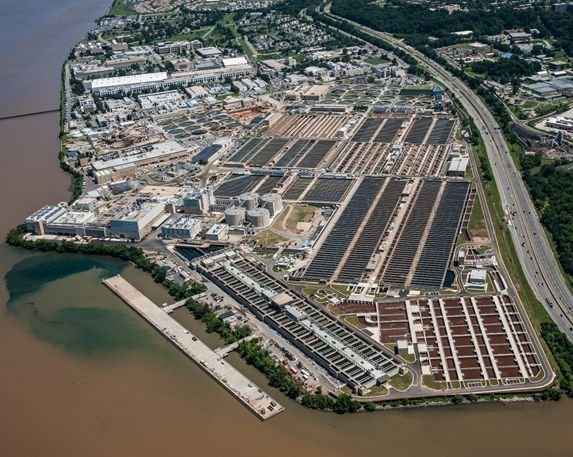Blue Plains Wastewater Facility in Washington DC Reinforces Facility Against Floods

The District of Columbia’s Blue Plains Wastewater Facility in Washington, DC, serves most of the national capital area, including parts of Maryland and Virginia. The service area of Blue Plains covers over 725 square miles.
This facility is vulnerable to flooding because of its location adjacent to the Potomac River. The facility has historically been protected from flooding by a seawall built to withstand a 1–100-year flood.
However, understanding that storms may become more frequent and intense, the DC Water and Sewer Authority decided to implement an adaptation action to prepare for more flooding due. This action included investing in a $113 million construction project to build a 17.2 ft high sea wall, with the first phase (Segment C), completed in June 2021. The new sea wall at the Blue Plains facility will surpass the recommended 500-year storm level by including 3 feet of freeboard to protect against higher river elevation or wave action.
Blue Plains has selected this standard as a proxy to adapt the facility to expected higher river elevation and storm surge inundation. This will help protect the facility against higher river levels and storm surges and reduce threats of Clean Water Act violations. Blue Plains took this action to promote resilience to current conditions and prepare for potiential changes in environmental conditions.
How Did They Do It?
- Blue Plains Identified Facility Vulnerability and Appropriate Adaptation Options -Blue Plains acknowledged the scientific uncertainty of how changes in environmental conditions would impact water levels in the Potomac River. As a major facility with a large investment along the riverfront, building a seawall to protect against flooding was deemed a preferable strategy rather than moving the entire facility to higher ground.
- Blue Plains Chose an Adaptation Action That Exceeded Current Best Practices to Account for Future Changes - Blue Plains utilized a proxy measurement to design the sea wall to account for uncertainty regarding how changes in the environment would impact Potomac River levels. The sea wall was designed to account for a currently expected 500-year flood and includes 3 feet of freeboard. This design exceeds FEMA’s flood risk standards for federally funded projects.
Similar Cases and More Information
Several other communities have adapted to protect their water and wastewater service from flooding and sea-level rise.
- To see how another northeastern community analyzed the impact of sea-level rise on a water utility, view Manchester-by-the-Sea.
- For a community that recognized the prohibitive cost of protecting a highly vulnerable facility and decided to move to a safer facility, see Iowa City.
- Protecting the Blue Plains facility is only one of several strategies Washington, D.C. has taken to reduce the threat of flooding on the community. To see how Washington, D.C. is using green infrastructure to reduce stormwater impacts and combined sewer overflows view the DC Consent Decree.
